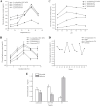Effects of novel flavonoid-enriched yogurt on the diversity of intestinal microbiota in mice
- PMID: 34449069
- PMCID: PMC8578235
- DOI: 10.1007/s42770-021-00598-w
Effects of novel flavonoid-enriched yogurt on the diversity of intestinal microbiota in mice
Abstract
Soy isoflavone glycoside cannot be effectively absorbed by the human intestinal tract, but probiotics with related hydrolases can transform it into aglycone to promote its absorption. In this study, a novel flavonoid-enriched yogurt was developed using an isolated β-glucosidase-producing strain (Lactiplantibacillus plantarum GY). The flavonoid aglycone-enhanced yogurt was fed to ICR mice for 21 days, and its effects were observed. The yogurt can affect the gut microbial diversity of mice, especially increasing the abundance of Parasutterella, the Bacteroidales S24-7 group, and Phascolarctobacterium in the intestinal tract of mice. Meanwhile, the ratio of Bacteroidetes/Firmicutes in the intestinal tract of mice fed with the flavonoid aglycone-enriched yogurt increased. The difference in the content of butyric acid between the L-GY + IS and the control groups was significant (P < 0.05). Therefore, milk fermentation with β-glucosidase-producing strains is a promising approach for developing flavonoid glycoside-enriched yogurt products.
Keywords: Flavonoids; Gut microbiota; Lactiplantibacillus plantarum; Short-chain fatty acids; β-glucosidase.
© 2021. Sociedade Brasileira de Microbiologia.
Conflict of interest statement
The authors declare no competing interests.
Figures







Similar articles
-
Soy yoghurts produced with efficient GABA (γ-aminobutyric acid)-producing Lactiplantibacillus plantarum ameliorate hyperglycaemia and re-establish gut microbiota in streptozotocin (STZ)-induced diabetic mice.Food Funct. 2023 Feb 6;14(3):1699-1709. doi: 10.1039/d2fo02708a. Food Funct. 2023. PMID: 36722409
-
Probiotic-enriched milk and dairy products increase gut microbiota diversity: a comparative study.Nutr Res. 2020 Oct;82:25-33. doi: 10.1016/j.nutres.2020.06.017. Epub 2020 Jul 6. Nutr Res. 2020. PMID: 32949953
-
Effects of Bifidobacterium animalis subsp. lactis BB-12 and yogurt on mice during oral antibiotic administration.Microbiol Res. 2024 Sep;286:127794. doi: 10.1016/j.micres.2024.127794. Epub 2024 May 31. Microbiol Res. 2024. PMID: 38852301
-
Matrix Effects on the Delivery Efficacy of Bifidobacterium animalis subsp. lactis BB-12 on Fecal Microbiota, Gut Transit Time, and Short-Chain Fatty Acids in Healthy Young Adults.mSphere. 2021 Aug 25;6(4):e0008421. doi: 10.1128/mSphere.00084-21. Epub 2021 Jul 7. mSphere. 2021. PMID: 34232082 Free PMC article. Clinical Trial.
-
Factors Influencing the Gut Microbiota, Inflammation, and Type 2 Diabetes.J Nutr. 2017 Jul;147(7):1468S-1475S. doi: 10.3945/jn.116.240754. Epub 2017 Jun 14. J Nutr. 2017. PMID: 28615382 Free PMC article. Review.
Cited by
-
Combination of Lactobacillus fermentum NS9 and aronia anthocyanidin extract alleviates sodium iodate-induced retina degeneration.Sci Rep. 2023 May 24;13(1):8380. doi: 10.1038/s41598-023-34219-3. Sci Rep. 2023. PMID: 37225720 Free PMC article.
-
Endogenous chitinase might lead to differences in growth performance and intestinal health of piglets fed different levels of black soldier fly larva meal.Anim Nutr. 2023 May 26;14:411-424. doi: 10.1016/j.aninu.2023.05.008. eCollection 2023 Sep. Anim Nutr. 2023. PMID: 37649680 Free PMC article.
References
-
- Brouns F. Soya isoflavones: a new and promising ingredient for the health foods sector. Food Res Int. 2002;35(2–3):187–193. doi: 10.1016/S0963-9969(01)00182-X. - DOI
MeSH terms
Substances
Grants and funding
- BE2018397/the Jiangsu Science and Technology Department
- CX (18)3036/Jiangsu Agricultural Science and Technology Innovation Fund
- 31671869, 32072192/Natural Science Foundation of China
- KF2020007/the open project program of the first-class bioengineering disciplines in zhejiang province
- 2020C02042/Key Research and Development Project of Zhejiang Province
LinkOut - more resources
Full Text Sources

